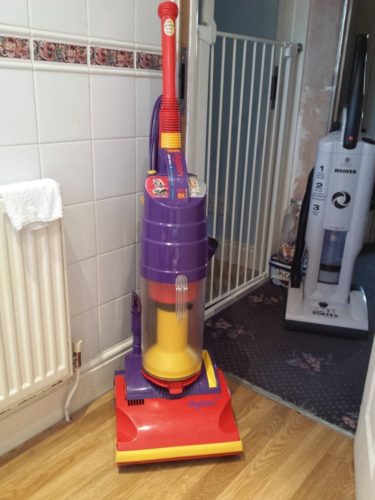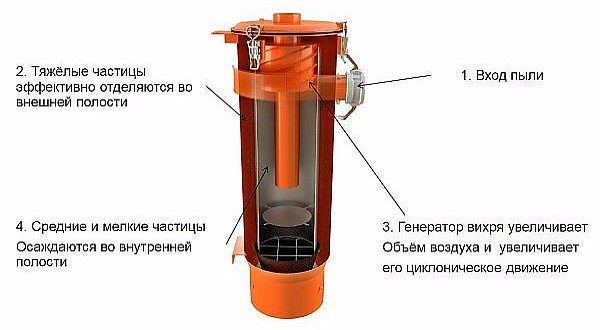How to make a cyclone filter for a vacuum cleaner with your own hands
Very often after repair and construction work there is a lot of garbage and dust that can be removed only with the help of a powerful vacuum cleaner. Since the usual home appliance is not suitable for these purposes, it is used construction vacuum cleaner, the filter for which can be homemade. How to make a cyclone for a vacuum cleaner with your own hands so that the unit can effectively cope with the cleaning of construction dust?
Content
Cyclone filter value
Those whose work is constantly connected with the repair, construction and carpentry business are familiar with the problem of cleaning the room after the completion of the actual work. Construction wood dust, loose plaster, the smallest grains of foam and drywall are usually deposited in a dense layer on all horizontal surfaces of the room.Wipe manually or sweep a broom like this disgrace is not always possible, because with a large area of the room such cleaning will take a long time. Wet cleaning is also often impractical: it is even more difficult to wipe off a mixture of water and thick dust.
In this case, the optimal solution is applying a vacuum cleaner. Standard vacuum cleaner, which we are accustomed to use in everyday life, will not work. Firstly, because of the large amount of debris, the dust collector will immediately clog, and you will need to clean it at least once every 15-20 minutes. Secondly, the ingress of large particles, for example, splinters, sawdust or wood chips can cause blockage or complete malfunction of the device.
Construction vacuum cleaner has a much higher powerthan household. Features of its engine provide long-term operation, and the presence of a long hose (3-4 m and more) allows you to clean a vast area.
However, industrial and construction vacuum cleaners have large dimensions, are not very convenient to use, clean and move, and are not affordable for everyone. Therefore, many craftsmen increase the possibilities of a household vacuum cleaner, supplying it with a special cyclone filter.Such dust collectors can be purchased as a finished product, or assemble your own version yourself.

We manufacture cyclone independently
In the world wide web you can find many detailed diagrams and drawings of cyclones. We give an example of making the simplest filter that can be collected at home, having the necessary materials, patience and a little skill. For work you will need:
- Any oil filter for small debris (such can be bought in auto accessories stores).
- Capacity 20-25 liters with a tightly screwed lid.
- Polypropylene knee with angles of 45 ° and 90 °.
- Pipe length of about one meter.
- Corrugated hose 2 meters long.
Next, perform a series of actions:
- Make a hole in the lid of the main container. The width of the hole is adjusted to a polypropylene knee with an angle of 90 °.
- Close the gap with sealant.
- On the side wall of the container, make another hole and attach a 45 ° angle.
- Connect the corrugated hose and the elbow with a pipe. Tilt the output hose towards the bottom so that the air with debris is directed along the required trajectory.
- The filter can be put on material from nylon or other permeable fabric in a small mesh. This will prevent large particles from entering the filter.
- Next, connect the knee on the cover and the outlet of the filter.
Of course, this is only a brief and approximate scheme for creating a cyclone. We present to your attention a video where, in detail and in an illustrative example, it is shown how to make a filter out of scrap materials.
We check the made filter for tightness, and also for quality of absorption. Garbage should be collected at the bottom of the tank or settle on the walls.
If everything is assembled correctly, suction will occur efficiently and at high speed.
The principle of operation of the cyclone filter
Creator cyclone vacuum cleaner was the physicist James Dyson. It was he who first developed the compact dust separator (or filter), which operates on the principle of centrifugal force. He established a patent for his invention - a vacuum cleaner brand "G-Force" - in 1986. Later, in the early 90s, Dyson launched the Dayson DC01 model, which entered the global market. What was the success of this technological innovation?

The cyclone filter is a unit of two chambers: external and internal.Under the influence of centrifugal force, all elements entering the vacuum cleaner (dust, debris, chips, etc.) begin spin in a spiral. That is why the cyclone filter for a universal vacuum cleaner has the shape of a cone: dust is spinning in it, as if in a funnel. At the same time, large particles of garbage are deposited in the first, external chamber, while small particles remain on the inside. Thus, thoroughly cleaned air comes out of the vacuum cleaner through the upper opening.

Advantages of the filter:
- There is no need for containers and disposable bags for collecting dust and their endless replacement.
- Compactness.
- Silent work.
- If the filter housing is transparent, you can control its contamination.
- High efficiency.
Vacuum cleaner with a similar filter is quite versatile, and is suitable for both home use and for industrial premises.
Having built a cyclone filter with your own hands, you can easily make and aqua filter for vacuum cleaner.

/rating_off.png)












